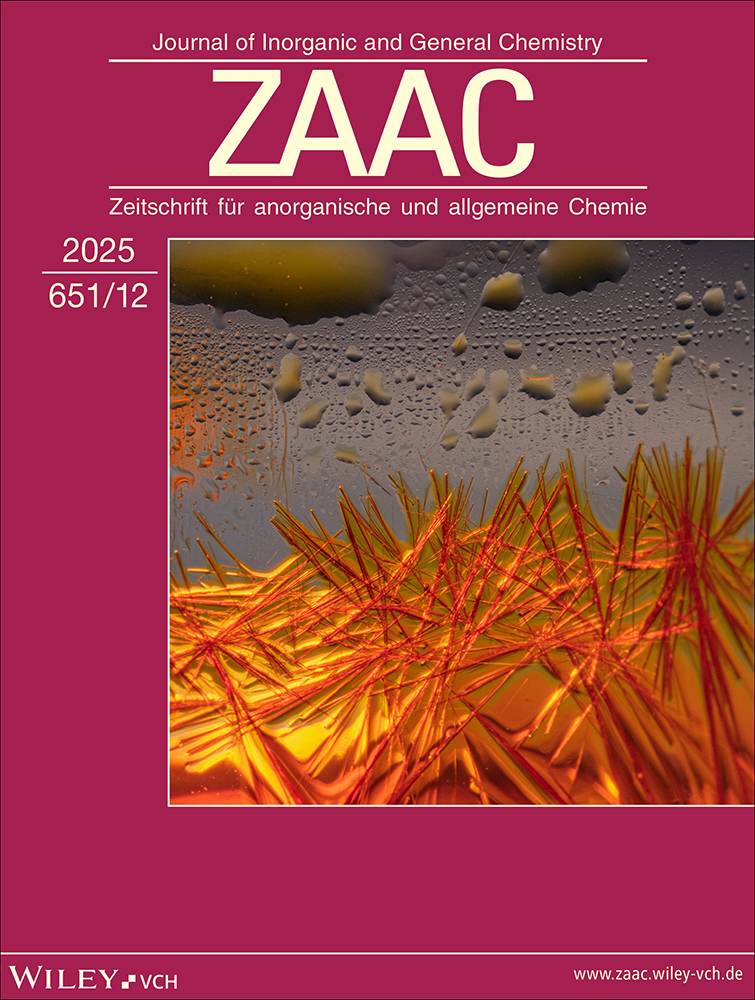Zur Chemie und Strukturchemie von Phosphiden und Polyphosphiden. 42. Trilithiumheptaphosphid Li3P7: Darstellung, Struktur und Eigenschaften†
Professor Klaus Brodersen zum 60. Geburtstage am 12. August 1986 gewidmet
Abstract
deTrilithiumheptaphosphid, Li3P7, wird durch Umsatz der Elemente bei 870 K in Nb- bzw. Ta-Ampullen erhalten. Die leuchtend gelbe (solvensfreie) Substanz kristallisiert in einem neuen Strukturtyp (P212121; a = 974,2(1) pm; b = 1053,5(1) pm; c = 759,6(1) pm; Z = 4). Die Struktur hat enge Beziehung zu den plastisch-kristallinen Phasen vom Rb3P7-Typ (Li3Bi-Variante). Die Heptaphosphanortricyclen-Anionen P73− sind jeweils von 12 Li-Kationen umgeben und in komplexer Weise miteinander verknüpft. Das Anion zeigt die für ionische Nortricyclene X73− typische Differenzierung von Abständen und Winkeln (PP-Abstände: d̄(Basis) = 224,9 pm; d̄(Basis-Brücke) = 214,7 pm und d̄(Brücke-Spitze) = 217,6 pm). Die Abstände Lithium-Phosphor liegen im Bereich 250 ≤ d(Li(2b)P−) ≤ 270 pm. Den Bindungsabständen PP und LiP entsprechen sinnvolle Pauling-Bindungsordnungen PBO. Li3P7 zeigt beim Erhitzen in geschlossenen Ampullen einen thermischen Effekt bei 900 K, der einem Phasenübergang 1. Ordnung in eine noch unbekannte HT-Phase entspricht. Beim thermischen Abbau erfolgt keine kongruente dissoziative Sublimation wie bei den anderen Heptaphosphiden M3P7, sondern Zersetzung zu LiP bzw. Li3P, welches dann kongruent dissoziativ verdampft. Lösungen von Li3P7 in en zeigen schon bei Raumtemperatur Valenzfluktuation des P73−-Anions (δ31P-NMR = -122,1). Über weitere Umsetzungen von Li3P7 wird berichtet. Die strukturellen Unterschiede zwischen Li3P7 und Solvaten Li3P7solv3 werden diskutiert.
Abstract
enChemistry and Structural Chemistry of Phosphides and Polyphosphides. 42. Trilithiumheptaphosphide Li3P7: Preparation, Structure, and Properties
Trilithium heptaphosphide, Li3P7, has been prepared by reaction of the elements at 870 K in Nb and Ta ampoules, respectively. The bright yellow (solventfree) substance crystallizes in a new structure type (P212121; a = 974.2(1) pm; b = 1053,5(1) pm; c = 759,6(1) pm; Z = 4). The structure is closely related to the plastically crystalline Rb3P7 type of structure (Li3Bi variant). The heptaphosphanortricyclene anions P73− are surrounded by 12 Li cations and connected one to each other in a complex manner. The anion exhibits a differentation of distances and angles typical for ionic nortricyclenes X73− (PP distances: d̄(basis) = 224.9 pm; d̄(basis-bridge) = 214.7 pm; d̄(bridge-bridgehead) = 217.6 pm). The distances Li to P are in the range of 250 ≤ d(Li(2b)P−) ≤ 270 pm. The PP and LiP bond distances are equivalent to meaningful Pauling bond orders PBO. On heating in closed ampoules, Li3P7 shows an endothermic effect at 900 K, corresponding to a first order phase transition into a HT phase of unknown nature up to now. On thermal decomposition no congruent dissociative sublimation occurs in contrast to the other heptaphosphides M3P7, but LiP and Li3P are formed, the latter evaporates congruently dissociative, Solutions of Li3P7 in en show valence fluctuation of the P73− anions already at room temperature (δ 31P-NMR = − 122.1). Further reactions of Li3P7 are reported as well as the structural differences between Li3P7 and the solvates Li3P7solv3 are discussed.




